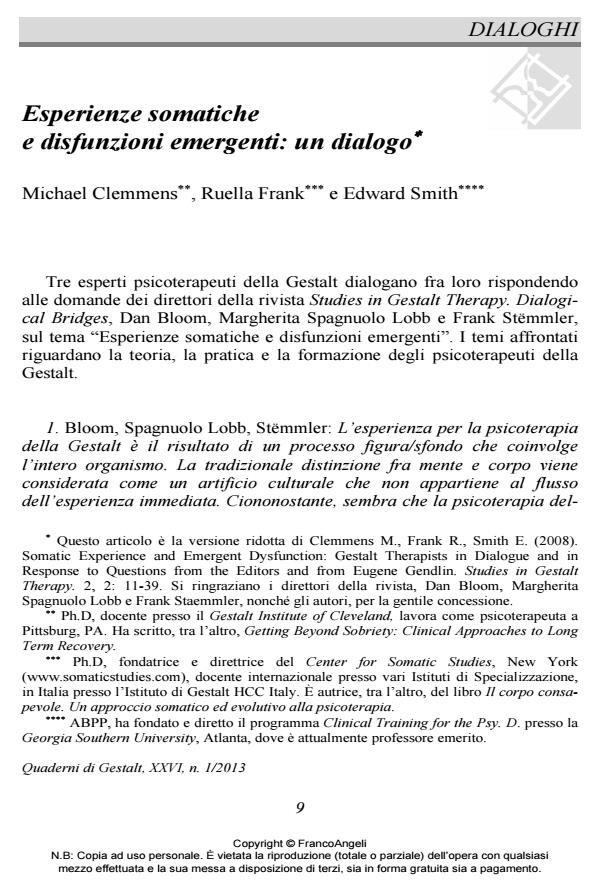Somatic Experiences and Emergent Dysfunctions
Journal title QUADERNI DI GESTALT
Author/s Michael Clemmens, Frank Ruella, Edward Smith
Publishing Year 2013 Issue 2013/1
Language Italian Pages 20 P. 9-28 File size 919 KB
DOI 10.3280/GEST2013-001002
DOI is like a bar code for intellectual property: to have more infomation
click here
Below, you can see the article first page
If you want to buy this article in PDF format, you can do it, following the instructions to buy download credits

FrancoAngeli is member of Publishers International Linking Association, Inc (PILA), a not-for-profit association which run the CrossRef service enabling links to and from online scholarly content.
This article is the shortened version of an article published into the International Journal Studies in Gestalt Therapy. Dialogical Bridges. The three editors of that journal (Dan Bloom, Margherita Spagnuolo Lobb and Frank Stëmmler) pose questions about bodily experience according to gestalt therapy to the authors, three main experts in the field. They answer from the background of basic gestalt principles, like the co-creation of contact in a field perspecitve, embodied experience of the relationship, sufferings as creative adjustments, etc. Gestalt therapy practise has developed along two main lines, one focused on body work, the other focused on verbal interventions. Today, theoreticians, clinicians, trainers, and students are engaged in the challenge of re-owning the integrative and wholistic sense that a phenomenological approach based on the primacy of experience requires.
Keywords: Body, olism, co-creation, embodied relationship, creative adjustment, experience, Gestalt therapy.
- Gestalt Therapy and Somatic Symptom Disorder: Clinical Reflections on Embodiment, Contact, and Relational Field Michele Cannavò, Dario Davì, Brenda Cervellione, in The Journal of Humanistic Counseling johc.70025/2025
DOI: 10.1002/johc.70025 - Una lettura gestaltica dei disturbi psicosomatici: "la pelle che brucia" Michele Cannavò, Dario Davì, Brenda Cervellione, in QUADERNI DI GESTALT 2/2024 pp.33
DOI: 10.3280/qg2024-2oa18163
Michael Clemmens, Frank Ruella, Edward Smith, Esperienze somatiche e disfunzioni emergenti: un dialogo in "QUADERNI DI GESTALT" 1/2013, pp 9-28, DOI: 10.3280/GEST2013-001002